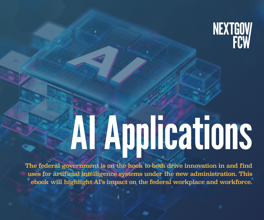Unleashing Digital Talent in the Next Administration, Part 2

xtock/Shutterstock.com
Tricks for CHCOs and CIOs can use to hire in-demand digital talent within existing rules.
W. Scott Gould is a senior adviser at Boston Consulting Group and former deputy secretary of the Veterans Affairs Department. Jeffrey Neal is a senior vice president at ICF International, former chief human capital officer for the Homeland Security Department, and publisher of the blog ChiefHRO.com.
This is the second in a series of two columns; read the first one here.
Despite the unnecessarily complex and outdated nature of today’s hiring system, it can work to achieve reasonable outcomes when a knowledgeable human resources expert and line leader cooperate and apply existing authorities in a tightly coordinated fashion. Here are some of the steps chief information officers and chief human capital officers can take together and in partnership with their respective IT and HR staff to work effectively within existing rules:
- Create the partnership between HR and IT. Both CHCOs and CIOs admit the partnership between their respective teams is not always strong. The Office of Personnel Management is so concerned about the lack of coordination between HR and hiring managers, it has sent representatives around the country to encourage and facilitate such partnerships. A clear dialogue is essential to any effective hiring program, whether it is using today’s rules or a reformed civil service hiring process. That dialogue can help HR staff understand the jobs they are trying to fill and help hiring managers understand their role in the process is critical and cannot be delegated to their administrative staff.
- Leverage existing hiring authorities. Agencies typically go to the same well repeatedly. Advertising only on the USAJobs website and using the traditional competitive hiring process is not proving successful. Some agencies, such as the Homeland Security Department and the Defense Department, have been given broad authority to hire tech talent. Others have excepted service authorities or agency-specific authority. Every agency can use OPM’s Pathways program, and an assortment of programs targeted to veteran hiring. OPM officials report agencies routinely ask for direct hire authority when they have made no attempt to use many of the hiring authorities they already have.
- Train existing staff. Agencies must put training at or near the top of their budget priority list. Too often, agencies that complain about not having enough qualified staff are not investing in developing the skills of the team they already have. Few agencies conduct training needs surveys and even fewer tie those surveys to a comprehensive workforce planning process that incorporates current and future skill requirements. Agencies should approach workforce development as a data-driven exercise that identifies current and future needs, assesses competencies of existing staff, and funds the training and development activities necessary to close the gaps they identify. The same data can also serve as the basis for building hiring programs based on anticipated demand rather than the reactive approach most agencies follow. Agencies should also encourage employees to invest in their own skill development by allowing time “on the clock” to pursue self-funded training or education.
- Put jobs where the talent lives. Roundtable participants described successes in recruiting in-demand talent when they had flexibility in determining where people could work. One participant whose agency has not pursued such flexibility said, “We have 100 offices all around the country. Why can’t we hire someone in Detroit or Kansas City and have them work from there?” The authors used that approach successfully at the Veterans Affairs Department and the Defense Logistics Agency. Today’s dual-income families are less willing to pick up and move to another part of the country for a job. The government has to adopt more flexible strategies if it wants to tap available talent.
- Create risk “circuit breakers” to protect people willing to experiment and innovate. Executive branch leaders and Congress continually ask civil servants to innovate, yet punish them when well-intended innovation fails. Senior managers’ careers are set back or sidelined when programs that challenge the status quo or try something new go off course. Failure happens. Government needs a way to contain the risk and consequences while allowing for experimentation. Further, when repeated poor performance requires action be taken, then managers need a system that can support accountability without fear of litigation.
- Use contractors, Federally Funded Research and Development Centers, Intergovernmental Personnel Act assignments, and other sources to acquire talent when the hiring process is not effective. Some agencies have been very successful in building a multisector workforce that finds talent where it exists and identifies ways to tap into it. The Defense Advanced Research Projects Agency, for example, describes its approach this way: “DARPA works within an innovation ecosystem that includes academic, corporate and governmental partners, with a constant focus on the nation’s military services, which work with DARPA to create new strategic opportunities and novel tactical options. For decades, this vibrant, interlocking ecosystem of diverse collaborators has proven to be a nurturing environment for the intense creativity that DARPA is designed to cultivate.” One roundtable participant said, “I think strengthening the partnership between industry and government in this space is in our collective interest. We need to be OK with the movement.”
- Expand the U.S. Digital Service model. Use this model as one of several “on-ramps” to attract technical talent. Match recruits with experienced government “guides” to help them adjust to the real-world constraints of technical management in a government environment.
In summary, HR and IT are not using the tools they have at their disposal or are not using them well because they fail to work as a unified team and lack the “master craftsmen” needed at every step of the process to apply the judgment and perspective required to get the job done. Direct hire authority may be a necessary last resort; but every agency should use the tools it already has. Those that cannot demonstrate the ability to do so are unlikely to make effective use of broad new authorities.
Positioning for Reform to Address the Biggest Roadblocks
The advantage of working within the current system is clear: greater mission success without delay. But the level of red tape and rework required even with highly skilled actors is excessive and it has become a barrier to hiring the right talent. The next president should take steps to reform the system and make it easier for others to use. Six key steps can make a substantial difference in the government’s ability to identify and hire the right talent.
- Simplify the hiring of recent college graduates to build a pipeline of new talent. The end of the Federal Career Intern Program and transition to Pathways coincided with a 58 percent drop in the number of new hires under age 30. The long-term effects of a workforce with few young people in the pipeline are obvious. Agencies should have the ability to recruit and hire on campus in the same manner as other large employers. That means they must be able to offer jobs on the spot and well in advance of graduation. Without that ability, agencies have little credibility as employers in a highly competitive market. To protect the rights of veterans and other applicants, the number of hires agencies make using such an authority should be limited to 25 percent of new hires annually.
- Collocate front-line hiring authority with better training and greater consequences for misuse of power. The “power imbalance” between HR and hiring managers has tilted too far toward HR. This has occurred as skill levels of HR specialists have declined and many hiring managers have pushed responsibility to HR. By extending greater hiring authority to managers trained and certified to exercise it, agencies can shift the balance and responsibility back to the hiring managers.
- Extend to every agency the authorities that OPM and agencies have tested for years in demonstration projects. The General Schedule, a relic of the mid-20th century, has outlived its usefulness as a job classification and pay model. Its inflexible grade and pay levels and multitude of job series confuse applicants, limit managers, and are a barrier to modern talent management. The job classification and pay flexibilities that have been repeatedly proven in demonstration projects are essential to compete for tech talent in the 21st century.
- Establish a Public Service Corps to bring talent into government for critical tech and high-impact projects. Not every task requires an employee who wants a career in government. A Public Service Corps, drawing on the government’s experience with the Peace Corps, VISTA (now AmeriCorps VISTA), and even the Depression-era Civilian Conservation Corps, can bring talented people into government early in their careers. This would allow them to put their skills to work on projects of national significance, then leave to work in the private sector, nonprofit organizations, state and local governments—or perhaps choose to continue working in the federal government.
- Extend and expand the CyberCorps Scholarship for Service program. This novel program offers to cover students’ tuition and fees and pay them a stipend while in school in return for a commitment to work for the US government full time for a period equal to their scholarship. For example, three academic years of scholarship requires three-year service commitment.
- Develop a campaign to improve skills in the HR and IT communities. Both occupations can benefit from better technical and leadership skills. OPM has made a start with its HR University, but far more is needed to build a cadre of highly capable HR professionals. Any advances agencies make through reformed hiring will be lost if they cannot retain new workers and maintain their skills.
Conclusion
Virtually no one believes the current system works effectively to recruit, develop and retain the tech talent essential for the digital government of the future. Statutory reforms handed off to poorly trained and equipped HR teams are unlikely to succeed. Continuing to blame HR staff for the failures of a system they did not design and cannot change will accomplish nothing. A combination of practical actions that can be taken now and reforms Congress and the next president can develop together, constitute a necessary and workable approach to advance the cause of digital government.





